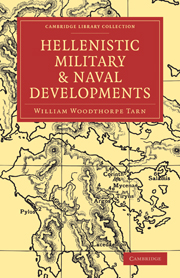Book contents
- Frontmatter
- PREFACE
- Contents
- Lecture I General Outline and Infantry
- Lecture II Cavalry and Elephants
- Lecture III Siege Warfare and Naval Warfare
- Appendix I The number of the Persian Cavalry
- Appendix II The Chinese evidence for the Great War-Horse
- Appendix III Surenas' Camels
- Appendix IV Δίκροτος in a recent papyrus
- Index
Lecture I - General Outline and Infantry
Published online by Cambridge University Press: 05 October 2010
- Frontmatter
- PREFACE
- Contents
- Lecture I General Outline and Infantry
- Lecture II Cavalry and Elephants
- Lecture III Siege Warfare and Naval Warfare
- Appendix I The number of the Persian Cavalry
- Appendix II The Chinese evidence for the Great War-Horse
- Appendix III Surenas' Camels
- Appendix IV Δίκροτος in a recent papyrus
- Index
Summary
My subject is the development of warfare in the Hellenistic period, that is, roughly speaking, in Greece and Asia between Alexander and Augustus; I am not dealing with Rome. I shall take first the general outline of the subject and the history of infantry; the second lecture will deal with the use of animals in war, that is, cavalry and elephants, for this was essentially the age of cavalry; the third lecture must be given to machines, that is, siege warfare and naval warfare. I am afraid that in this lecture I shall only be treating well-known things, but I hope afterwards to have a little that is new both about horses and about ships. It may be an unfortunate thing that war should have occupied such a large place in the outlook of every State during the period I am considering, but if we are going to try and understand the ancient world we cannot leave out any part of it. Some indeed believe that for the Graeco-Roman world war was at first, speaking generally, the normal condition and peace the abnormal one, and it is not difficult to find facts to support this, such as treaties of peace made for a short and definite term of years.
The warfare of the little states of classical Greece had once been a kind of seasonal occupation; the harvest was reaped early, and there was little to do for the rest of the summer: there were not many amusements, so you fought somebody.
- Type
- Chapter
- Information
- Hellenistic Military and Naval Developments , pp. 1 - 49Publisher: Cambridge University PressPrint publication year: 2010First published in: 1930



